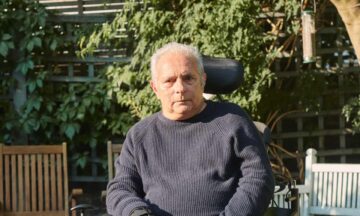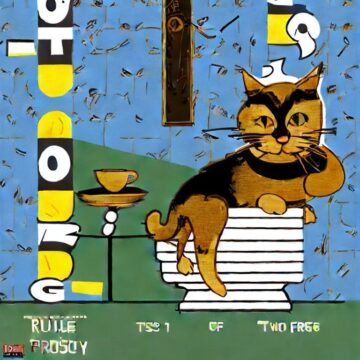Enjoying the content on 3QD? Help keep us going by donating now.
Category: Recommended Reading
Sunday, November 3, 2024
No Exit Opportunities: Business Models and Political Thought in Silicon Valley
Henry Farrell in American Affairs:
It’s a rare buccaneer who runs a book club. But in October 2012, the chief administrator of the Silk Road drug market, under the pseudonym “Dread Pirate Roberts,” was on the dark web assigning readings from the anarchist libertarian philosophy of Murray Rothbard. Rothbard had argued that markets and individual connections were really all we needed. As the Dread Pirate, whose real name was Ross Ulbricht, summarized it, a happier world awaited those who took the exit road from ordinary politics. They could escape the “thieving murderous mits [sic]” of the state to embrace the freedom that emerged from a “multitude of voluntary interactions between individuals.”
For Ulbricht, Silk Road wasn’t just a way to make money but the tech-fueled expression of a political philosophy. Cryptocurrencies like Bitcoin had (supposedly) enabled a new realm of voluntary exchange outside the grasp of government, allowing people to buy and sell drugs and guns without the feds interfering. Of course, state tyranny might reemerge if voluntary organizations like Silk Road started to steal from their users, or spied on, or even killed them. Ulbricht, however, believed that the forces of market competition would prevent this from happening, leading to “freedom and prosperity the likes of which the world has never known.”
Ambitious libertarian projects to escape the sordid compromises of politics have been part of Silicon Valley culture since the beginning. But Ulbricht’s dream of escape from politics and its vexations has become increasingly influential in the decade since the Dread Pirate Roberts book club. Several prominent Silicon Valley investors and entrepreneurs have become disenchanted with the U.S. government, East Coast media, and even their own employees (which have all increasingly become disenchanted with them).
More here.
Enjoying the content on 3QD? Help keep us going by donating now.
Where Americans Work
Andrew Yamakawa Elrod interviews Gabriel Winant in Phenomenal World:
Andrew Elrod: The health insurance issue seems conspicuously absent from the election. What do you make of that?
Gabriel Winant: In some ways, both parties would find it convenient for the issue to be absent. But despite their efforts—partly to suppress it and partly to express subsections of the issue opportunistically—the social service industries nonetheless have a way of working themselves back toward the surface.
Just a few examples: JD Vance has talked about repealing Obamacare, without acknowledging that’s what he’s talking about. He’s floated the idea of separating more acute, sicker healthcare subscribers into their own insurance pools—which would basically repeal Obamacare’s pre-existing conditions regulation. But when pressed, he denies it, which is symptomatic of the general way that Republicans can’t generate a coherent popular line on healthcare. That arises from the pathologies of the sector itself. Republicans learned their lesson on Obamacare. It was politically remunerative to them for years to campaign against Obamacare when it was unpopular. The turning point was the struggle over “repeal and replace” in 2017—public opinion had changed. Enough people had become enrolled in Medicaid through its higher income eligibility and in other plans through the subsidies for the exchanges that Republicans can no longer actually campaign against it openly. They may translate it into questions about gender-affirming care or reproductive care—which is also a way of talking about it without talking about it. But unlike before, they’re not campaigning on private “health savings plans.”
The Democrats have a different problem: they’re accountable to conflicting constituencies, one of whom is the master, one of whom is not. If there were a primary process, the politically weaker left wing of the party would have had a chance to assert itself and extract some symbolic concessions, given the popularity of lowering healthcare premiums, rolling back hospital prices, and expanding Medicare and Medicaid coverage as voting issues. Harris would now be trying to back away from certain political concessions to the left.
More here.
Enjoying the content on 3QD? Help keep us going by donating now.
Are We on the Cusp of a New Political Order?
Ezra Klein interviews Gary Gerstle in the NYT:
Ezra Klein: So let’s begin with the big concept here. What is a political order?
Gary Gerstle: A political order is a way of thinking differently about political time in America. We focus so much on two-, four- and six-year election cycles. A political order is something that lasts beyond particular elections, that refers to the ability of one political party to arrange a constellation of policies, constituencies, think tanks, candidates, individuals who come to dominate politics for extended periods of time. And their dominance becomes so strong that the opposition party feels compelled — if they still want to remain real players in American politics — it compels them to acquiesce and to come aboard the other political party’s platform. They don’t get established that often. They usually last 30 or 40 years. Economic crisis is usually involved in the emergence of a new order and the breakup of the old. Every political order also has not only an ideology but a vision of a good life in America.
What constitutes a good life? Because that becomes really important in terms of selling the virtues of that political order to a mass base, which is something that has to be won and sustained in American politics in order for a political order to exist and thrive.
More here.
Enjoying the content on 3QD? Help keep us going by donating now.
The Parenting Panic
Aaron Bady in Boston Review:
My grandmother was a good Catholic who didn’t go to college and had eight children. Her oldest child went to college and had one child, me. Your own family probably fits this pattern. In a decline that correlates with education and secularism, and is concentrated in the Global North, women across the world are having about half the number of children they had only fifty years ago.
The far right sees this choice as a specific kind of crisis. While anti-abortion, anti-immigrant nationalists like J. D. Vance might not use exactly fourteen words when they rail against “childless cat ladies,” they echo eugenicists like Madison Grant and Theodore Roosevelt in blaming female emancipation for “race suicide.” America was “great” when (white) families were large because (white) women were in the home having children, and (white) labor was cheap enough to make large-scale (nonwhite) immigration unnecessary. It does not mitigate the problem that about half of the current rate of population increase in the United States comes from new immigration; for them, that is the problem.
The liberal counternarrative tends to be a smaller story, about individuals choosing not to be parents. More people are making this choice, they concede, but the important question is whether people are choosing freely. Are those who never wanted children—especially women historically forced into childbearing—finally free to forgo them? Or are those who would want children choosing not to have them, for economic or cultural reasons, or out of anxiety about a war-ridden, warming world?
However strange it may sound to characterize the post-Roe present as overflowing with reproductive choice, the mainstream center-left tends to agree with the far right that this choice is a new phenomenon, and that our predecessors were spared the existential dilemma.
More here.
Enjoying the content on 3QD? Help keep us going by donating now.
Gary Indiana (1950 – 2024) Writer and Artist
Enjoying the content on 3QD? Help keep us going by donating now.
Phil Lesh (1940 – 2024) Bassist, Founding Member of Grateful Dead
Enjoying the content on 3QD? Help keep us going by donating now.
Shattered by Hanif Kureishi – picking up the pieces
Dina Nayeri in The Guardian:
 All day, all night the body intervenes,” wrote Virginia Woolf in On Being Ill. It “blunts or sharpens, colours or discolours, turns to wax in the warmth of June, hardens to tallow in the murk of February. The creature within can only gaze through the pane – smudged or rosy; it cannot separate off from the body.”
All day, all night the body intervenes,” wrote Virginia Woolf in On Being Ill. It “blunts or sharpens, colours or discolours, turns to wax in the warmth of June, hardens to tallow in the murk of February. The creature within can only gaze through the pane – smudged or rosy; it cannot separate off from the body.”
On Boxing Day 2022, in Rome with his Italian partner Isabella, Hanif Kureishi felt dizzy while sitting at the table. He fainted, landing on his neck and becoming tetraplegic as a result. He spent 2023 in Italian and English hospitals, being prodded, rearranged and invaded while sending dispatches to his fans (dictated to Isabella and to his son, Carlo) via his popular Substack. “I will never go home again. I have no home now, no centre. I am a stranger to myself. I don’t know who I am any more. Someone new is emerging.” Now, those dispatches have been collected, edited, and expanded into a memoir.
More here.
Enjoying the content on 3QD? Help keep us going by donating now.
The Coming of the ‘Messiah’: How Handel’s Masterpiece Was Born
John Adams in The New York Times:
 “Mr. Handel’s head is more full of Maggots than ever. … I could tell you more … but it grows late & I must defer the rest until I write next; by which time, I doubt not, more new ones will breed in his Brain.”
“Mr. Handel’s head is more full of Maggots than ever. … I could tell you more … but it grows late & I must defer the rest until I write next; by which time, I doubt not, more new ones will breed in his Brain.”
The probably feigned harrumph about the composer was aired by one Charles Jennens, a wealthy 18th-century English country squire, art and book collector, music lover, hoarder of manuscripts and all-around aesthete who some years later would provide both the concept and the text for what would become the most popular and enduring musical work of all time: the oratorio that, despite Jennens’s contribution, we know as “Handel’s ‘Messiah.’” A solitary bachelor, self-described as “puny,” Jennens was subject to depression and “violent perturbations and anxieties of the mind.” Aside from his God in heaven, the moody and melancholic impresario had one overriding passion in life: the music of his German-born composer friend, he of the maggots in the brain. For Jennens, George Frideric Handel was “the Prodigious,” a genius whose talent, fecundity and theatrical acumen dominated English musical life for nearly a half-century.
Jennens is just one of an improbable list of characters who populate Charles King’s new book, “Every Valley: The Desperate Lives and Troubled Times That Made Handel’s ‘Messiah.’” King uses Handel’s famous oratorio, what he calls “the greatest piece of participatory art ever created,” as a hub the spokes of which radiate outward to a host of key historical forces and personalities that characterize 18th-century Britain. A work of vivid social and cultural commentary, it functions also as an in-depth study of artistic creation, not only of how “Messiah” came to be, but also of the unstoppable spigot that was Handel’s musical imagination.
More here.
Enjoying the content on 3QD? Help keep us going by donating now.
Patricia Johanson (1940 – 2024) Artist
Enjoying the content on 3QD? Help keep us going by donating now.
Friday, November 1, 2024
The Final Flight of the Airline Magazine
Lucy Schiller in the Columbia Journalism Review:
 There were, of course, other ways to feel connected with humanity on a plane. You could notice a slight indentation left in the seat from the person before you, or the length to which they had extended (or shortened) their seatbelt, which would now become yours. You didn’t have to turn to the back of the in-flight magazine to see some stranger’s—or, more likely, strangers’—handiwork on the crossword, or wonder what flavor of sticky substance someone had spilled across its pages. Nor was it required to retrace the doodles drawn on the ads for UNTUCKit shirts, It’s Just Lunch, Hard Rock Café, Wellendorff jewelry, companies selling gold coins, and Big Green Eggs. But it’s clear that with the last print issue of Hemispheres, the in-flight magazine of United Airlines, and the last such magazine connected to a major US carrier (with the exception of Hana Hou!, for Hawaiian Airlines), it is the end of an era.
There were, of course, other ways to feel connected with humanity on a plane. You could notice a slight indentation left in the seat from the person before you, or the length to which they had extended (or shortened) their seatbelt, which would now become yours. You didn’t have to turn to the back of the in-flight magazine to see some stranger’s—or, more likely, strangers’—handiwork on the crossword, or wonder what flavor of sticky substance someone had spilled across its pages. Nor was it required to retrace the doodles drawn on the ads for UNTUCKit shirts, It’s Just Lunch, Hard Rock Café, Wellendorff jewelry, companies selling gold coins, and Big Green Eggs. But it’s clear that with the last print issue of Hemispheres, the in-flight magazine of United Airlines, and the last such magazine connected to a major US carrier (with the exception of Hana Hou!, for Hawaiian Airlines), it is the end of an era.
More here.
Enjoying the content on 3QD? Help keep us going by donating now.
Physics Nobel-winner John Hopfield on solving problems between fields
Elizabeth Gibney in Nature:
 John Hopfield, one of this year’s winners of the Nobel Prize in Physics, is a true polymath. His career started with probing the physics of solid states during the field’s heyday in the 1950s before moving to the chemistry of haemoglobin in the late 1960s, and studying DNA synthesis in the decade that followed.
John Hopfield, one of this year’s winners of the Nobel Prize in Physics, is a true polymath. His career started with probing the physics of solid states during the field’s heyday in the 1950s before moving to the chemistry of haemoglobin in the late 1960s, and studying DNA synthesis in the decade that followed.
In 1982, he devised a brain-like network in which neurons — which he modelled as interacting particles — formed a kind of memory. The ‘Hopfield network’, for which he was awarded the Nobel Prize, is now widely seen as a building-block of machine learning, which underpins modern artificial intelligence (AI). Hopfield shared the award with AI pioneer Geoffrey Hinton at the University of Toronto in Canada.
Now 91 years old, Hopfield, an emeritus professor at Princeton University in New Jersey, spoke to Nature about whether his prizewinning work was really physics and why we should worry about AI.
More here.
Enjoying the content on 3QD? Help keep us going by donating now.
Podcast Hosts Discover They’re AI, Not Human, and Spiral Into Existential Meltdown
Enjoying the content on 3QD? Help keep us going by donating now.
The debate over Trump’s style of politics obscures his profound indecency
Francis Fukuyama at Persuasion:
 The publication of new interviews with Donald Trump’s longstanding chief of staff John Kelly have been in the news since last week, and the Harris campaign has picked up on Kelly’s use of the word “fascist” to describe his former boss. This has reignited a longstanding debate over whether Trump and his MAGA movement represent the threat of genuine fascism in the United States were he to be re-elected.
The publication of new interviews with Donald Trump’s longstanding chief of staff John Kelly have been in the news since last week, and the Harris campaign has picked up on Kelly’s use of the word “fascist” to describe his former boss. This has reignited a longstanding debate over whether Trump and his MAGA movement represent the threat of genuine fascism in the United States were he to be re-elected.
This debate misses the point in several respects. Most Americans don’t have a clear definition of “fascist” in their minds, except to know that it means something very bad. But they also know that it’s been an epithet thrown around a lot, especially at Republican candidates. Indeed, as one Republican campaign ad shows, virtually every one of their presidential candidates over recent decades has been described as a fascist by the Democrats.
More here.
Enjoying the content on 3QD? Help keep us going by donating now.
David Katzenstein’s ‘Distant Journeys’
David Katzenstein at Commonweal:
 In the brief introduction to Distant Journeys, a new collection of photography assembled from trips undertaken over nearly five decades and across six continents, David Katzenstein tells us that his “passion for discovery” began early. Perhaps it was when he was only three years old, gripping his father’s back as their “frisky gray mare” galloped across a beach in Cuba, or when he visited Norway at age seven and watched a waterfall plunge half a kilometer into the sea below. It’s not surprising that he became a photographer: both memories, distant but visually and metaphorically precise, evoke the shifting perspectives that have defined his work throughout his career.
In the brief introduction to Distant Journeys, a new collection of photography assembled from trips undertaken over nearly five decades and across six continents, David Katzenstein tells us that his “passion for discovery” began early. Perhaps it was when he was only three years old, gripping his father’s back as their “frisky gray mare” galloped across a beach in Cuba, or when he visited Norway at age seven and watched a waterfall plunge half a kilometer into the sea below. It’s not surprising that he became a photographer: both memories, distant but visually and metaphorically precise, evoke the shifting perspectives that have defined his work throughout his career.
At first glance, the few images presented here, though taken in places as far-flung as Senegal, India, and Sicily, are neither exotic nor extraordinary. They show people going about their daily lives: milling around in a market, dancing in a sweaty living room, snapping photos at a festival with their phones. But there’s mystery here, too.
more here.
Enjoying the content on 3QD? Help keep us going by donating now.
Friday Poem
Dating in the Apocalypse Bunker
You take the lamp with your last battery
and meet me at the radios, where it’s quiet,
and we can be alone. I like how the light dims
and flickers, the way it plays across the steel.
I like how we can’t see the sand in the air.
You hold my gloved hand in your gloved hand
and we walk the hydroponic halls. I love you
because your eyes are green, because we eat
protein cans and you tell me about birds,
how your dad still has grass in his vault.
And we’re dressed to the nines, in our cleanest
boots, the dust scrubbed from our tanks
until they gleam. Our utility suits are beeping
beneath our helmet read-outs, but no longer
are we clumsy, like those men who fled to Mars.
And we go not to the movies but to the oxygen
chambers, where we crouch low, lean close
to a vent. You shed your gear first, lips dry
and desert-cracked, and we share that same
recycled air, press our mouths against the wall,
breathe so deeply we see stars.
by Kristen Mears
from Palette Poetry
Enjoying the content on 3QD? Help keep us going by donating now.
David Katzenstein: A Photographic Journey of Ritual
Enjoying the content on 3QD? Help keep us going by donating now.
The poetry of revolution
Diane Fieldes in R:
 Capitalism thwarts and stunts the creativity of human beings. It robs the mass of the population of control over their own labour, and therefore over production generally. It denies the vast majority of people creative expression in their daily work lives, and this affects all of life. Workers are robbed not just of artistic creativity but even of our potential to be an audience for art. Yet there is a constant struggle to free humanity’s potential. And there have always been troublesome artists and troublesome art. The contradictions of capitalism mean that it is possible, at least to some extent, for artistic expression to develop in opposition to the dominant trajectory of society. Bertolt Brecht’s poem “Motto” makes the point:
Capitalism thwarts and stunts the creativity of human beings. It robs the mass of the population of control over their own labour, and therefore over production generally. It denies the vast majority of people creative expression in their daily work lives, and this affects all of life. Workers are robbed not just of artistic creativity but even of our potential to be an audience for art. Yet there is a constant struggle to free humanity’s potential. And there have always been troublesome artists and troublesome art. The contradictions of capitalism mean that it is possible, at least to some extent, for artistic expression to develop in opposition to the dominant trajectory of society. Bertolt Brecht’s poem “Motto” makes the point:
In the dark times
Will there also be singing?
Yes, there will also be singing.
About the dark times.
But at high points of struggle, the possibilities of artistic expression expand exponentially. One of the chief aims of socialist revolution, according to the Russian revolutionary Leon Trotsky, is the “awakening of human personality in the masses – who were supposed to possess no personality”.
More here.
Enjoying the content on 3QD? Help keep us going by donating now.
Why the Medical Establishment Often Gets It Wrong
Lola Butcher in Undark Magazine:
 Like many surgeons, Marty Makary used to routinely treat appendicitis by removing the patient’s appendix, a procedure performed nearly 300,000 times a year in the U.S. That changed about a decade ago after he read a research study that found antibiotics may be an effective alternative. Despite subsequent research confirming that appendectomies can often be avoided, Makary estimates only about half of surgeons have accepted the idea. “That means whether or not you go under the knife for appendicitis today in America depends on who’s on call when you walk into the emergency department,” he writes in “Blind Spots: When Medicine Gets It Wrong, and What It Means for Our Health.”
Like many surgeons, Marty Makary used to routinely treat appendicitis by removing the patient’s appendix, a procedure performed nearly 300,000 times a year in the U.S. That changed about a decade ago after he read a research study that found antibiotics may be an effective alternative. Despite subsequent research confirming that appendectomies can often be avoided, Makary estimates only about half of surgeons have accepted the idea. “That means whether or not you go under the knife for appendicitis today in America depends on who’s on call when you walk into the emergency department,” he writes in “Blind Spots: When Medicine Gets It Wrong, and What It Means for Our Health.”
In detailed behind-the-scenes case studies, Makary, a surgeon and public health researcher at Johns Hopkins University, reveals how and why physicians often salute bad science and baseless opinions at the peril of their patients. Among other things, Makary claims, the medical establishment created the opioid epidemic and the peanut allergy epidemic. Tens of thousands of women have died prematurely because of misinterpreted data about the danger of hormone replacement therapy. The U.S. government banned silicone breast implants for 14 years without evidence they caused harm. Physicians’ overuse of antibiotics is likely causing untold suffering. Doctors still tell overweight people to eat low-fat foods, even though low-fat diets are associated with obesity and diabetes.
More here.
Enjoying the content on 3QD? Help keep us going by donating now.
Eat Poop You Cat: The Humanity of GenAI Art
Rachel Ossip at n+1:
 New image-making technologies — whether the printing press, the camera, or satellite imaging — change our perception of the world, which in turn changes our behaviors. The question at hand is: What are these algorithmic images teaching us to see, say, and do?
New image-making technologies — whether the printing press, the camera, or satellite imaging — change our perception of the world, which in turn changes our behaviors. The question at hand is: What are these algorithmic images teaching us to see, say, and do?
As of January 2024, GenAI text-to-image tools produced about thirty-four million images per day. This number is still dwarfed by the daily count of digital photographs, but for how long? From here on out, it’s safest to assume that any image you encounter might be generated. What differentiates these images is not their lack of humanity but their intense abundance of it: all the alienated intelligence, historical strata, and linguistic tics embedded and reproduced within them. Each prompter sets off a huge chain of networked collaboration with artists and academics, clickworkers and random internet users, across time and space, engaging in one massive, multicentury, ongoing game of Eat Poop You Cat. Like it or not, we all — whether pre-algorithmic image makers or self-described AI artists — will have to learn to play.
more here.
Enjoying the content on 3QD? Help keep us going by donating now.
